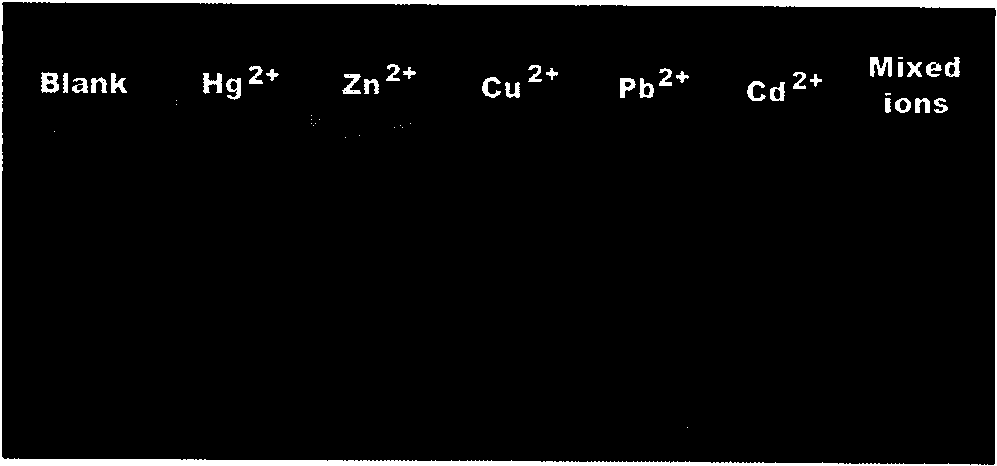Analytical method for detecting trace mercury in aqueous medium based on the color change of fluorescence
A technology for detecting water and medium, applied in fluorescence/phosphorescence, material excitation analysis, etc., can solve the problem of few reports of direct sensitive detection, and achieve the effects of high sensitivity, low preparation cost and high repeatability
- Summary
- Abstract
- Description
- Claims
- Application Information
AI Technical Summary
Problems solved by technology
Method used
Image
Examples
Embodiment 1
[0031] Weigh an appropriate amount of the synthesized conjugated oligopyrene derivatives and the homopolynucleic acid containing 8 bases T into two reagent bottles, and dissolve them with ultrapure water to prepare an aqueous solution with an equimolar concentration of 2.5 ×10 -5 mol L -1 . The two solutions were then mixed at room temperature and allowed to stand for 10 min. Pipette 13 portions of 5 mL of this solution as a test solution. Then, drop the K to be measured into the system + , Ba 2+ , Ca 2+ , Cd 2+ ,Co 2+ , Cu 2+ , Fe 3+ , Fe 2+ , Mg 2+ , Mn 2+ , Ni 2+ , Pb 2+ , Zn 2+ sample. The final concentration of each ion is 1.25×10 -4 mol L -1 mol L -1 . Complex detection solution for Hg 2+ The fluorescent response of the fluorescent sensor system was excited by a portable UV-ultraviolet lamp at 25°C, and the excitation wavelength was 365nm. The results showed that the blue fluorescence of the sensing system was not affected by the relevant alkali me...
Embodiment 2
[0033] Weigh an appropriate amount of the synthesized conjugated oligopyrene derivative and the homopolymeric nucleic acid containing 8 bases T and place them in two reagent bottles respectively, and use a concentration of 10 mmol L. -1 ; The Tris-HCl buffer of pH=7.5 is dissolved and prepared into an aqueous solution of equimolar concentration, and its concentration value is 2.5×10 -5 mol L -1 . The two solutions were then mixed at room temperature and allowed to stand for 10 min. Pipette 13 portions of 5 mL of this solution as the detection solution. Then, the K to be measured is added dropwise to the system + , Ba 2+ , Ca 2+ , Cd 2+ , Co 2+ , Cu 2+ , Fe 3+ , Fe 2+ , Mg 2+ , Mn 2+ , Ni 2+ , Pb 2+ , Zn 2+ sample. The final concentration of each ion is 1.25×10 -4 molL -1 mol L -1 . Complex detection solution to Hg 2+ The fluorescence response of the fluorescence sensing system was excited by a portable UV-ultraviolet lamp at 25 °C, and the excitation wave...
Embodiment 3
[0035] Weigh an appropriate amount of the synthesized conjugated oligopyrene derivative and the homopolymeric nucleic acid containing 8 bases T and place them in two reagent bottles respectively, and use a concentration of 10 mmol L. -1 ; The Tris-HCl buffer of pH=7.5 is dissolved and prepared into an aqueous solution of equimolar concentration, and its concentration value is 2.5×10 -5 mol L -1 . The two solutions were then mixed at 40°C and left to stand for 10 min. Pipette 13 portions of 5 mL of this solution as the detection solution. Then, the K to be measured is added dropwise to the system + , Ba 2+ , Ca 2+ , Cd 2+ , Co 2+ , Cu 2+ , Fe 3+ , Fe 2+ , Mg 2+ , Mn 2+ , Ni 2+ , Pb 2+ , Zn 2+ sample. The final concentration of each ion is 1.25×10 -4 mol L -1 . Complex detection solution to Hg 2+ The fluorescence response of the fluorescence sensing system was excited by a portable UV-ultraviolet lamp at 25 °C, and the excitation wavelength was 365 nm. The r...
PUM
| Property | Measurement | Unit |
|---|---|---|
| area | aaaaa | aaaaa |
Abstract
Description
Claims
Application Information
 Login to View More
Login to View More - R&D
- Intellectual Property
- Life Sciences
- Materials
- Tech Scout
- Unparalleled Data Quality
- Higher Quality Content
- 60% Fewer Hallucinations
Browse by: Latest US Patents, China's latest patents, Technical Efficacy Thesaurus, Application Domain, Technology Topic, Popular Technical Reports.
© 2025 PatSnap. All rights reserved.Legal|Privacy policy|Modern Slavery Act Transparency Statement|Sitemap|About US| Contact US: help@patsnap.com



